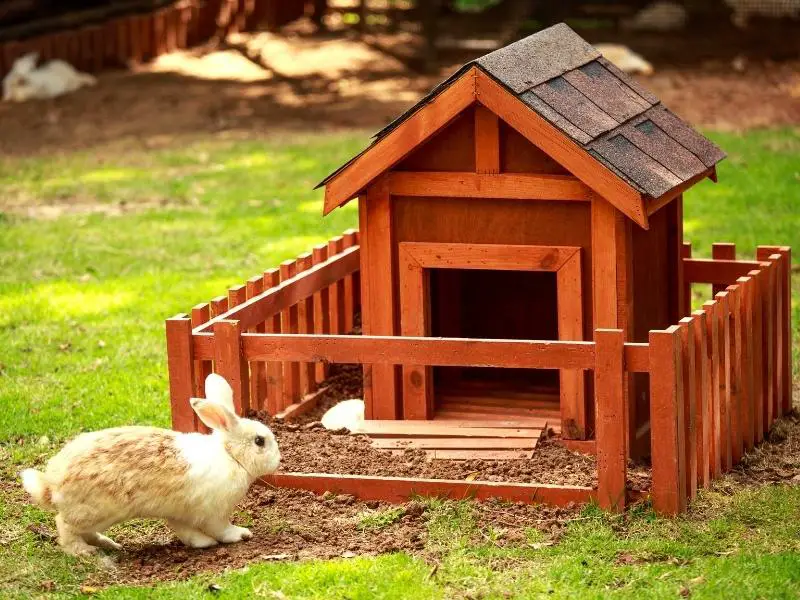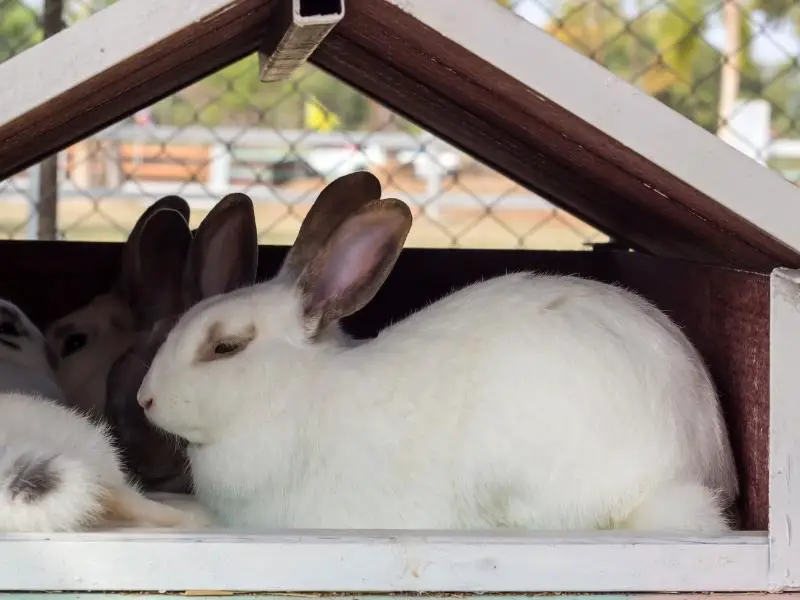How much space a rabbit needs is a hot topic in the world of rabbit ownership with a lot of debate. Even products in pet stores and online stores marketed as “deluxe rabbit homes” are too small for a pet rabbit. And then what if you have more than one pet rabbit in the house?
Rabbits are happier in a space that is bigger rather than smaller for them. The minimum requirement of living space is 12 square feet, or the rabbit cage or hutch should be a minimum of 3-4 times bigger than your rabbit. The exercise run should be a minimum of 32 square feet and be attached to the living space.
Your bunny should be able to sleep, eat, potty, and hop in the cage. The exercise run should be big enough so your rabbit can be running and playing with toys that allow them to dig, climb, and more.
Let’s look further into the topic of how much space does a rabbit need so you can ensure your pet bunny has sufficient space to be happy and healthy.
How Much Space Needed Per Rabbit?
Some rabbit owners will tell you that the minimum space you need for your bun is 8 square feet, while others will say that 12 square feet are the minimum requirement. It is always better to ensure your rabbit has more space than less.
If the space you give your rabbit is too small, your bun will get irritated, bored, and unhappy. They can also become depressed, which can lead to serious health problems, or engage in aggressive or destructive behavior.
You can work on a general space requirement of 3-4 times the size of your rabbit. For a smaller rabbit, a rabbit cage or hutch of 24 inches by 36 inches should be sufficient. And for a larger rabbit, the cage or hutch can be 30 inches by 36 inches.
However, it is best to measure your rabbit and also take note of the factors below that might affect the space requirement for your pet bunny.
Factors That Affects Space Requirement

There are various factors that you need to consider when choosing the best-sized cage or hutch for your bunny:
Rabbit Breed
Rabbit breeds range from dwarf to giant: there’s the 2-pound Netherland Dwarf rabbit and the 15-pound Flemish Giant rabbit. The cage you need for these rabbits will surely not be the same size.
So while the minimum 12 square feet rabbit housing size is valuable, it is merely a starting point and a guide.
Rabbit Size
You want to take your rabbit’s size that they are now into consideration – if they are a kit or young – as well as their size when they mature. You don’t want to buy 2 enclosures, so buy a rabbit cage that will work for your rabbit now and when they are mature-sized.
So how do you know how big your rabbit will be when they are mature? When your young bunny is 4 months old, they are roughly half the size of their adult size. And when your bunny is 6-8 months old, they are about ⅔ of their size as an adult bunny.
Measure your rabbit when they are fully sprawled out from the tip of their nose to the end of their hind feet.
Your rabbit hutch or cage should be 3-4 times this length so your rabbit can comfortably hop 3-4 times. The height of the enclosure should be 1.5-2 times the size of the rabbit when they stand upright on their hind legs.
Housing Type
There are various housing types available in which you can let your rabbit stay.
One of the most important factors here is to ensure that the rabbit “house” is large enough so your rabbit cannot get hurt:
- Your rabbit should be able to give 3 hops in all directions and stretch out comfortably.
- The hutch or cage should be long enough so your rabbit can easily move around to play, feed, drink, and exercise.
- The cage or hutch should be high enough without the rabbit’s ears touching the top when the bunny stands upright on its hind legs.
Quantity – Number of Rabbits
If you have more than one rabbit, you need a larger area. On average, you will need double the 12 square feet minimum for a pair of rabbits and a minimum of 36 square feet for 3 rabbits.
However, this all depends on how big your rabbits are. So you may need a smaller area for dwarf rabbits or a much larger area for large or giant breeds.
If you have a mix of breeds, work out the size of your enclosure based on the largest bunnies.
Things to Consider Before Choosing a Rabbit Cage
Other factors to consider when choosing a rabbit cage or rabbit are:
Location
The location where you place the cage or hutch matters. Whether you place it outside or inside, ensure the enclosure size fits comfortably. This includes both the living and the exercise parts of the rabbit house.
If it is placed outside, ensure your rabbits can choose whether they want sun or shade, and the hutch shouldn’t be in a location where it is very windy.
When you place the cage or pen inside, bunny-proof your home so your rabbit can’t get into any trouble when they are outside of their cage.
Another consideration here is that the hutch should be safe and secure and predator-proof for the outdoors.
Bedding
Provide enough bedding to cover the floor of the hutch or cage. In winter, you need to add more bedding so your bunnies can burrow into the bedding to stay warm.
Sufficient Space
In the cage or hutch, your rabbit needs plenty of space to hop around, a quiet area to sleep in, an area where they can potty (or where you can place the litter box), and somewhere they can eat hay and drink water.
Your rabbit also has play and exercise needs. It’s ideal to place the exercise run together with the hutch or cage and make sure your rabbit can get from one area to the other as they please.
If the living space is a minimum of 12 square feet, the exercise pen should be a minimum of 36 square feet. The two areas should be linked together with a ramp or a tunnel so your bun can get from the living area to the exercise area as needed.
My Last Bunny Thoughts
Your rabbit’s home should be big enough for your rabbit.
You can move comfortably from room to room in your home and stand up straight without worrying that your head will bump the ceiling or doorways. Your rabbit wants the same things.
With plenty of room for food and water, to feel safe, to sleep, to play and exercise, to potty, and more, your rabbit will be happy and trust you to take care of their needs.
Related Articles:

